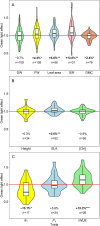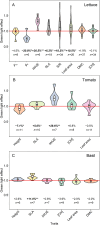Green light is similarly effective in promoting plant biomass as red/blue light: a meta-analysis
- PMID: 38829698
- PMCID: PMC11427831
- DOI: 10.1093/jxb/erae259
Green light is similarly effective in promoting plant biomass as red/blue light: a meta-analysis
Abstract
Whether green light promotes or represses plant growth is an unresolved but important question, warranting a global meta-analysis of published data. We collected 136 datasets from 48 publications on 17 crop species, and calculated the green light effect for a range of plant traits. For each trait the effect was calculated as the ratio between the trait value attained under a red/blue background light plus green, divided by the value attained under the background light only, both having the same light intensity. Generally, green light strongly increased intrinsic water use efficiency (15%), the shoot-to-root ratio (13%), and decreased stomatal conductance (-15%). Moreover, green light increased fresh weight to a small extent (4%), but not plant dry weight, resulting in a reduced dry matter content (-2%). Hence, green light is similarly effective at increasing biomass as red and blue light. Green light also showed to increase leaf area (7%) and specific leaf area (4%; i.e. thinner leaves). Furthermore, effects of green light were species-dependent, with positive effects on biomass for lettuce and microgreens, and negative effects in basil and tomato. Our data suggest that future research should focus on the role of green light in modulating water loss, its putative role as a shade signal, and the causes for its species-specific effects on crop biomass.
Keywords: Green light; LED; intrinsic water use efficiency; meta-analysis; plant growth; quantitative analysis; shoot–root ratio; stomatal conductance.
© The Author(s) 2024. Published by Oxford University Press on behalf of the Society for Experimental Biology.
Conflict of interest statement
The authors declare no conflicts of interest.
Figures





Similar articles
-
Green Light Partial Replacement of Red and Blue Light Improved Drought Tolerance by Regulating Water Use Efficiency in Cucumber Seedlings.Front Plant Sci. 2022 May 31;13:878932. doi: 10.3389/fpls.2022.878932. eCollection 2022. Front Plant Sci. 2022. PMID: 35712603 Free PMC article.
-
Dependence of far-red light on red and green light at increasing growth of lettuce.PLoS One. 2024 Nov 15;19(11):e0313084. doi: 10.1371/journal.pone.0313084. eCollection 2024. PLoS One. 2024. PMID: 39546482 Free PMC article.
-
Blue Photons from Broad-Spectrum LEDs Control Growth, Morphology, and Coloration of Indoor Hydroponic Red-Leaf Lettuce.Plants (Basel). 2023 Mar 2;12(5):1127. doi: 10.3390/plants12051127. Plants (Basel). 2023. PMID: 36903988 Free PMC article.
-
Critical Leaf Magnesium Thresholds and the Impact of Magnesium on Plant Growth and Photo-Oxidative Defense: A Systematic Review and Meta-Analysis From 70 Years of Research.Front Plant Sci. 2019 Jun 18;10:766. doi: 10.3389/fpls.2019.00766. eCollection 2019. Front Plant Sci. 2019. PMID: 31275333 Free PMC article.
-
N uptake and distribution in crops: an agronomical and ecophysiological perspective.J Exp Bot. 2002 Apr;53(370):789-99. doi: 10.1093/jexbot/53.370.789. J Exp Bot. 2002. PMID: 11912222 Review.
Cited by
-
How to utilize far-red photons effectively: substitution or supplementation with photosynthetically active radiation? A case study of greenhouse lettuce.BMC Plant Biol. 2025 Feb 19;25(1):228. doi: 10.1186/s12870-025-06205-6. BMC Plant Biol. 2025. PMID: 39972440 Free PMC article.
-
Advanced technologies in plant factories: exploring current and future economic and environmental benefits in urban horticulture.Hortic Res. 2025 Jan 27;12(5):uhaf024. doi: 10.1093/hr/uhaf024. eCollection 2025 May. Hortic Res. 2025. PMID: 40206515 Free PMC article.
-
Plant photosynthesis in basil (C3) and maize (C4) under different light conditions as basis of an AI-based model for PAM fluorescence/gas-exchange correlation.Front Plant Sci. 2025 May 19;16:1590884. doi: 10.3389/fpls.2025.1590884. eCollection 2025. Front Plant Sci. 2025. PMID: 40458213 Free PMC article.
-
A guide to understanding and measuring photosynthetic induction: considerations and recommendations.New Phytol. 2025 Jul;247(2):450-469. doi: 10.1111/nph.70218. Epub 2025 Jun 1. New Phytol. 2025. PMID: 40452130 Free PMC article. Review.
References
-
- Bantis F, Smirnakou S, Ouzounis T, Koukounaras A, Ntagkas N, Radoglou K.. 2018. Current status and recent achievements in the field of horticulture with the use of light-emitting diodes (LEDs). Scientia Horticulturae 235, 437–451.
-
- Bian Z, Cheng R, Yang Q, Wang J, Lu C.. 2016. Continuous light from red, blue, and green light-emitting diodes reduces nitrate content and enhances phytochemical concentrations and antioxidant capacity in lettuce. Journal of the American Society for Horticultural Science 141, 186–195.
-
- Bian Z, Zhang X, Wang Y, Lu C.. 2019. Improving drought tolerance by altering the photosynthetic rate and stomatal aperture via green light in tomato (Solanum lycopersicum L.) seedlings under drought conditions. Environmental and Experimental Botany 167, 103844.
Publication types
MeSH terms
Grants and funding
LinkOut - more resources
Full Text Sources

